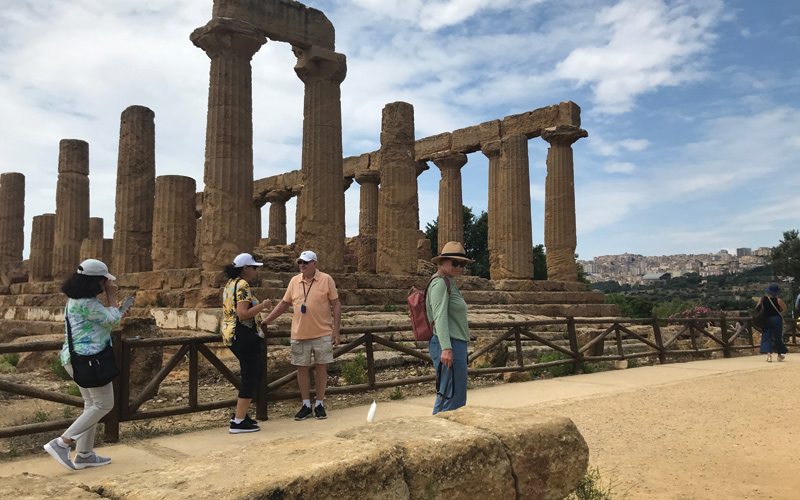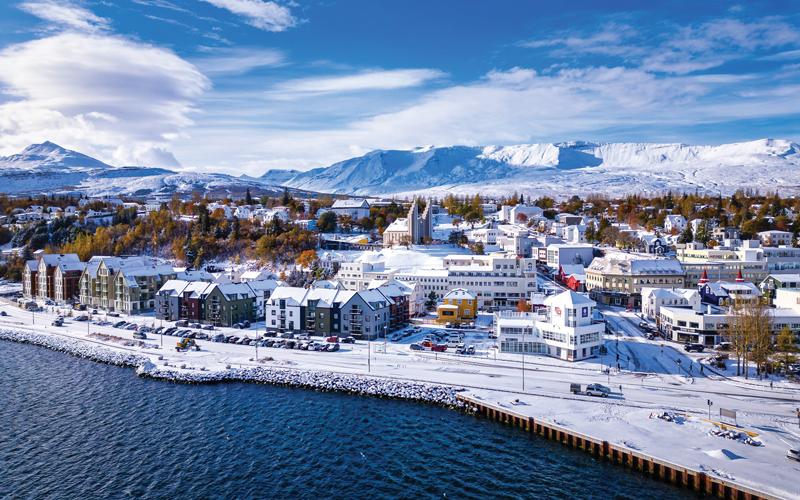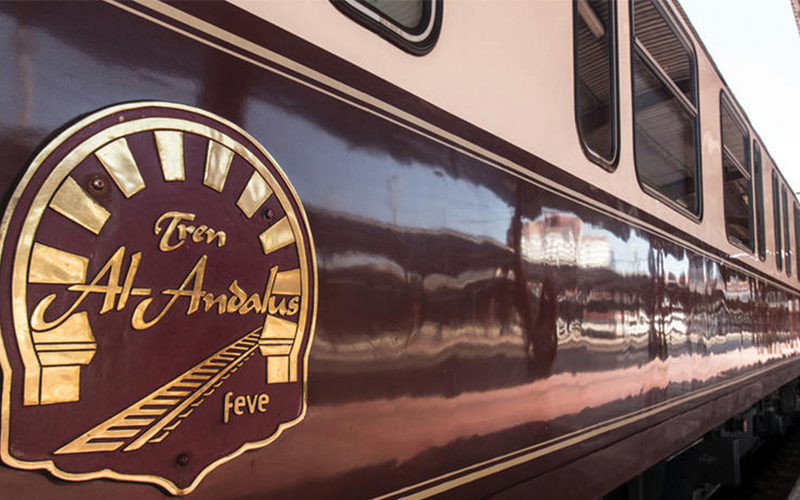Agrigento: Italy’s Capital of Culture for 2025
This year, Agrigento has been crowned the Italian Culture Capital for 2025.

Recently, Airbnb named Palermo, the major gateway and capital of Sicily, one of the hottest spots for 2025. As Rome will be hosting Holy Year, this could be the best time to head far south to Sicily so plan at least a three-night stay in magical Agrigento.
Mt. Etna’s snowy peak on the east side of the island remains visible on the nearly two-hour drive from Palermo’s Falcone- Borsellino Airport to Agrigento as if it was Sicily’s compass. Set on a ridge whose terraces of ancient olive trees amid those unmistakable Greek temples known as Valle dei Templi (Valley of Temples), Agrigento can take one’s breath away.
Valle dei Templi
The Valle dei Templi is such a world-renown cultural icon that PBS television recently aired a concert there by an acclaimed Italian trio, a performance evocative of the Three Tenors. You can see more at Il Volo in the Valley of the Temples.
This is the land of Demeter (Goddess of Harvest) and her daughter, Persephone (Goddess of Agriculture) not to mention Venera (Goddess of Love, Beauty, and Fertility) where Erice’s castle was built over her temple. The mother-daughter goddesses were worshiped with fervor on the west side of Agrigento’s archeological park. From the dark winter months, the goddesses promise to bring spring, which arrives early in Sicily.
Everyone who was anyone on the ancient theater circuit has already visited Sicily. The Phoenicians, Greeks, Byzantines, Arabs, Normans, Aragones, Angevinins, the House of Savoy, Austrians and Bourbons, have all left their marks. Throughout Sicily, in addition to their phrases, you’ll also find their recipes (including biscotti, marzipan, couscous, and more). There are also grapes and the lightweight carob pods that grow on trees not far from the twisted olive trees at the foot of the temples.
Not unlike their potential Greek conquerors, Sicilians are quite proud of who they are. They have preserved their culture and various dialects, which they fought hard to keep. This is the reason they did not become “Hellenized,” but remained unabashedly Sicilian.
History of Agrigento
Founded as a Greek colony in 6 B.C. when it was called Akragas, its Valle dei Templi is home to five ancient temples: Concordia, Juno, Castor and Pollux, Jupiter, and Hercules, all set on a plateau overlooking the sea.
Designated a UNESCO World Heritage site since 1997, Agrigento is listed in countless travel brochures. Yet it is usually only a stop between other places, but hardly ever an overnight, leaving it as one of Sicily’s most famous travel icons but so underappreciated.
Here old crafts such as cart-making still survive, as does the Santo Spirito Monastery in Agrigento proper. One of the most famous medieval buildings in Agrigento, it still shelters cloistered nuns making sweets as they always have. Set on top of the Via Atena, it’s possible to visit their small, beautiful museum while the bells toll.
Besides those well-preserved temples, Agrigento also has other stars: the nearby Sicani Mountains, the Torre Salsa Nature Reserve, and the Scala dei Turchi. And, of course, there’s the heart of the
city itself.
Inside the city local guides can lead guests to overlooked gems, some hosting special events this year such as the Pietro Griffo Archaeological Museum, with more than 5,000 artifacts. It is a vital key to understanding the vast importance of the temples. Named for an archeologist and overseer of the archeological park, you’ll find it in the center of the city. Part of it is annexed to the adjacent church of San Nicola that dates to the 14th century. Other sites in town include the Santa Maria dei Greci Church (13th century), which stands on the remains of a pagan temple.
Also visit the Luigi Pirandello Theater, which predictably stages its productions in Italian. To give you an idea of Pirandello’s status, in the theater’s foyer you’ll find two busts: one of Zeus, the other Pirandello.
Food and Wine
Centuries of volcanic eruptions have endowed Sicily with incredibly fertile soil. Farmers, vintners and fisheries build on these ancient foundations for biological or organic farming and fishing. From fish (fresh and smoked) to oranges to carob, grapes, almonds, pistachios, pomegranates, olives and olive oils –Sicily is the third largest producer of wines right behind the Veneto and Emilia Romagna. This is Nero d’Avola and Cerasuolo di Vittoria country although a number of varietals are now being experimented with.
When to go, Where to Stay, Who to Travel with …
Spring arrives early in Sicily with the annual Sagra del Mandorlo in Fiore, the Almond Festival usually set for the first Saturday in March. Because Agrigento wears the Culture crown this year, events are dotted throughout the calendar all of 2025.
Agrigento’s luxury hotel inventory ranges from the in-town five-star Hotel Villa Athena, to the four-star Colleverde Park Hotel. There is also the country inn of Hotel Baglio della Luna, restored by a local antiques dealer.
There are also simpler properties such as the three-star Hotel Miravalle in Ribera (home of those fabulous oranges). The Villa Sikania Park Hotel, about 10 miles west of Agrigento in Sikuliana, provides ample parking and an amazing pool.
Agriturismo ventures dot the countryside on former family estates such as the Baglio Laura in Licata and the 18th century farmhouse now the Baglio San Nicola. More lavish resorts include the Hotels Demetra Resort and the Hotel Dioscuri Bay Palace. The Baia di Ulisse near the beach features a wellness center and spa.
For those who prefer to travel in small groups, an ideal way to visit is to book a few days with a specialist company such as the highly regarded, New York-based LaRosaWorks. Owner Karen La Rosa can customize a stay with a guide and transportation, – not to mention inside info when it comes to food and wine. Agents might want to inform themselves with La Rosa’s numerous videos and “Guide to Sampling Wines and Wineries in Sicily.” https://www.larosaworks.com/#newsLterSignup
Getting There
Most carriers that fly from the U.S. to Europe operate service to Rome and Milan with connecting flights to Sicily. There are also non-stops from NY to Catania on Delta and from Newark to Palermo on United — both offered “in season.”
From New York’s JFK, NEOS operates two weekly non-stop flights to Palermo, Sicily and four weekly flights to Milan. Starting June 3rd through October 15, it will operate one weekly flight to Bari, Puglia on Italy’s eastern coast.
NEOS Airlines: (877) 865-2868; (212) 557-1645; https://us.neosair.com
Ita Airways (formerly Alitalia) operates non-stop flights from San Francisco, Los Angeles, Washington DC, New York, Miami, and Boston to Rome’s Fiumicino and Milan’s Malpensa Airports. Ita Airways: 877-793-1717; https://www.ita-airways.com/en_en
For more information contact the Italian Tourist Board: (212) 245-5618;
www.italiantourism.com





